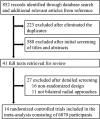Comparative efficacy and safety of the left versus right radial approach for percutaneous coronary procedures: a meta-analysis including 6870 patients
- PMID: 26108097
- PMCID: PMC4541695
- DOI: 10.1590/1414-431X20154571
Comparative efficacy and safety of the left versus right radial approach for percutaneous coronary procedures: a meta-analysis including 6870 patients
Abstract
The radial approach is widely used in the treatment of patients with coronary artery disease. We conducted a meta-analysis of published results on the efficacy and safety of the left and right radial approaches in patients undergoing percutaneous coronary procedures. A systematic search of reference databases was conducted, and data from 14 randomized controlled trials involving 6870 participants were analyzed. The left radial approach was associated with significant reductions in fluoroscopy time [standardized mean difference (SMD)=-0.14, 95% confidence interval (CI)=-0.19 to -0.09; P<0.00001] and contrast volume (SMD=-0.07, 95%CI=-0.12 to -0.02; P=0.009). There were no significant differences in rate of procedural failure of the left and the right radial approaches [risk ratios (RR)=0.98; 95%CI=0.77-1.25; P=0.88] or procedural time (SMD=-0.05, 95%CI=0.17-0.06; P=0.38). Tortuosity of the subclavian artery (RR=0.27, 95%CI=0.14-0.50; P<0.0001) was reported more frequently with the right radial approach. A greater number of catheters were used with the left than with the right radial approach (SMD=0.25, 95%CI=0.04-0.46; P=0.02). We conclude that the left radial approach is as safe as the right radial approach, and that the left radial approach should be recommended for use in percutaneous coronary procedures, especially in percutaneous coronary angiograms.
Figures





References
-
- Jolly SS, Yusuf S, Cairns J, Niemela K, Xavier D, Widimsky P, et al. Radial versus femoral access for coronary angiography and intervention in patients with acute coronary syndromes (RIVAL): a randomised, parallel group, multicentre trial. Lancet. 2011;377:1409–1420. doi: 10.1016/S0140-6736(11)60404-2. - DOI - PubMed
-
- Agostoni P, Biondi-Zoccai GG, de Benedictis ML, Rigattieri S, Turri M, Anselmi M, et al. Radial versus femoral approach for percutaneous coronary diagnostic and interventional procedures; Systematic overview and meta-analysis of randomized trials. J Am Coll Cardiol. 2004;44:349–356. doi: 10.1016/j.jacc.2004.04.034. - DOI - PubMed
-
- Jolly SS, Amlani S, Hamon M, Yusuf S, Mehta SR. Radial versus femoral access for coronary angiography or intervention and the impact on major bleeding and ischemic events: a systematic review and meta-analysis of randomized trials. Am Heart J. 2009;157:132–140. doi: 10.1016/j.ahj.2008.08.023. - DOI - PubMed
-
- Roussanov O, Wilson SJ, Henley K, Estacio G, Hill J, Dogan B, et al. Cost-effectiveness of the radial versus femoral artery approach to diagnostic cardiac catheterization. J Invasive Cardiol. 2007;19:349–353. - PubMed
Publication types
MeSH terms
LinkOut - more resources
Full Text Sources
Medical

